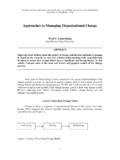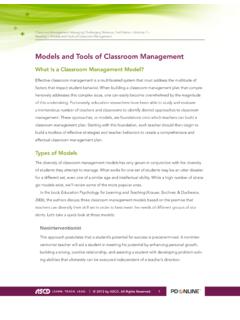Transcription of Evolution and Revolution as Organizations Grow
1 1 Mainiero, L. and Tromley, C. Developing Managerial Skills in Organizational Behavior: Exercises, Cases, and Readings (Englewood Cliffs, NJ: Prentice Hall) (2d ed. 1994), pp. 322-329. Evolution and Revolution as Organizations Grow Larry E. Greiner A small research company chooses too complicated and formalized an organization structure for its young age and limited size. It flounders in rigidity and bureaucracy for several years and is finally acquired by a larger company. Key executives of a retail store chain hold on to an organization structure long after it has served its purpose, because their power is derived from this structure. The company eventually goes into bankruptcy. A large bank disciplines a "rebellious" manager who is blamed for current control problems, when the underlying cause is centralized procedures that are holding back expansion into new markets.
2 Many younger managers subsequently leave the bank, competition moves in, and profits are still declining. The problems of these companies, like those of many others, are rooted more in past decisions than in present events or outside market dynamics. Historical forces do indeed shape the future growth of Organizations . Yet management, in its haste to grow, often overlooks such critical developmental questions as: Where has our organization been? Where is it now? And what do the answers to these questions mean for where we are going? Instead, its gaze is fixed outward toward the environment and the future--as if more precise market projections will provide a new organizational identity. Companies fail to see that many clues to their future success lie within their own Organizations and their evolving states of development. Moreover, the inability of management to understand its organization development problems can result in a company becoming "frozen" in its present stage of Evolution or, ultimately, in failure, regardless of market opportunities.
3 My position in this article is that the future of an organization may be less determined by outside forces than it is by the organization's history. In stressing the force of history on an organization, I have drawn from the legacies of European psychologists (their thesis being that individual behavior is determined primarily by previous events and experiences, not by what lies ahead). Extending this analogy of individual development to the problems of organization development, I shall discuss a series of developmental phases through which growing companies tend to pass. But, first, let me provide two definitions: 1. The term Evolution is used to describe prolonged periods of growth where no major upheaval occurs in organization practices. 2. The term Revolution is used to describe those periods of substantial turmoil in organization life.
4 As a company progresses through developmental phases, each evolutionary period creates its own Revolution . For instance, centralized practices eventually lead to demands for decentralization. Moreover, the nature of management's solution to each revolutionary period determines whether a company will move forward into its next stage of evolutionary growth. As I shall show later, there are at least five phases of organization 2 development, each characterized by both an Evolution and a Revolution . KEY FORCES IN DEVELOPMENT During the past few years a small amount of research knowledge about the phases of organization development has been building. Some of this research is very quantitative, such as time-series analyses that reveal patterns of economic performance over The majority of studies, however, are case-oriented and use company records and interviews to reconstruct a rich picture of corporate Yet both types of research tend to be heavily empirical without attempting more generalized statements about the overall process of development.
5 A notable exception is the historical work of Alfred D. Chandler, Jr., in his book Strategy and This study depicts four very broad and general phases in the lives of four large companies. It proposes that outside market opportunities determine a company's strategy, which in turn determines the company's organization structure. This thesis has a valid ring for the four companies examined by Chandler, largely because they developed in a time of explosive markets and technological advances. But more recent evidence suggests that organization structure may be less malleable than Chandler assumed; in fact, structure can play a critical role in 1 See, for example, William H. Starbuck, "Organizational Metamorphosis," in Promising Research Directions, edited by R. W. Millman and M. P.
6 Hottenstein (Tempe, Arizona, Academy of Management, 1968), p. 113. 2 See, for example, the Grangesberg case series, prepared by C. Roland Christensen and Bruce R. Scott, Case Clearing House, Harvard Business School. 3 Strategy and Structure: Chapters in the History of the American Industrial Enterprise (Cambridge, Massachusetts, The Press, 1962). influencing corporate strategy. It is this reverse emphasis on how organization structure affects future growth which is highlighted in the model presented in this article. From an analysis of recent studies,4 five key dimensions emerge as essential for building a model of organization development: 1. Age of the organization. 2. Size of the organization. 3. Stages of Evolution . 4. Stages of Revolution . 5. Growth rate of the industry. I shall describe each of these elements separately, but first note their combined effect as illustrated in Exhibit I.
7 Note especially how each dimension influences the other over time; when all five elements begin to interact, a more complete and dynamic picture of organizational growth emerges. After describing these dimensions and their interconnections, I shall discuss each evolutionary/revolutionary phase of development and show (a) how each stage of Evolution breeds its own Revolution , and (b) how management solutions to each Revolution determine the next state of Evolution . Age of the Organization The most obvious and essential dimension for any model of development is 4 I have drawn on many sources for evidence: (a) numerous cases collected at the Harvard Business School; (b) Organization Growth and Development, edited by William H. Starbuck (Middlesex, England, Penguin Books, Ltd., 1971), where several studies are cited; and (c) articles published in journals, such as Lawrence E.
8 Fouraker and John M. Stopford, "Organization Structure and the Multinational Strategy," Administrative Science Quarterly, Vol. 13, No. 1, 1968, p. 47; and Malcolm S. Salter, "Management Appraisal and Reward Systems," Journal of Business Policy, Vol. 1, No. 4, 1971. 3 the life span of an organization (represented as the horizontal axis in Exhibit I). All historical studies gather data from various points in time and then make comparisons. From these observations, it is evident that the same organization practices are not maintained throughout a long time span. This makes a most basic point management problems and principles are rooted in time. The concept of decentralization, for example, can have meaning for describing corporate practices at one time period but loses its descriptive power at another. The passage of time also contributes to the institutionalization of managerial attitudes.
9 As a result, employee behavior becomes not only more predictable but also more difficult to change when attitudes are outdated. Size of the Organization This dimension is depicted as the vertical axis in Exhibit I. A company's problems and solutions tend to change markedly as the number of employees and sales volume increase. Thus time is not the only determinant of structure; in fact, Organizations that do not grow in size can retain many of the same management issues and practices over lengthy periods. In addition to increased size, however, problems of coordination and communication magnify, new functions emerge, levels in the management hierarchy multiply, and jobs become more interrelated. Stages of Evolution As both age and size increase, another phenomenon becomes evident: the prolonged growth that I have termed the evolutionary period.
10 Most growing Organizations do not expand for two years and then retreat for one year; rather, those that survive a crisis usually enjoy four to eight years of continuous growth without a major economic setback or severe internal disruption. The term Evolution seems appropriate for describing these quieter periods because only modest adjustments appear necessary for maintaining growth under the same overall pattern of management. Stages of Revolution Smooth Evolution is not inevitable; it cannot be assumed that organization growth is linear. Fortune's "500" list, for example, has had significant turnover during the last 50 years. Thus we find evidence from numerous case histories which reveals periods of substantial turbulence spaced between smoother periods of Evolution . I have termed these turbulent times the periods of Revolution because they typically exhibit a serious upheaval of management practices.


















